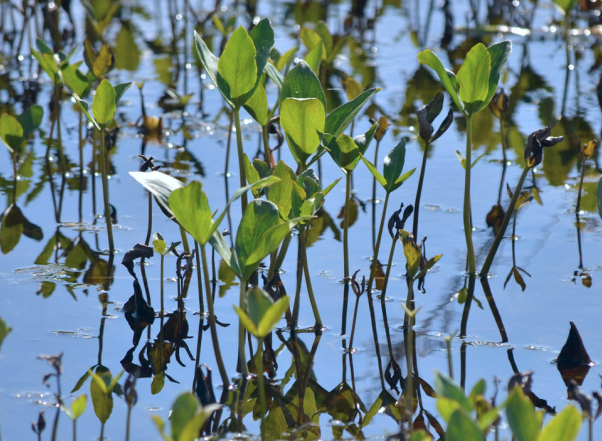
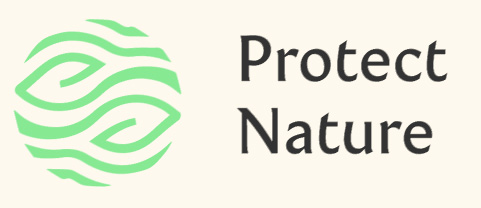
Historically; the natural landscape of Ireland was predominantly a wooded one. Despite the significantly reduced areas of woodland that now exist; many of Ireland’s plants found in the open countryside are characteristic of woodland.
There are specialised plant communities occurring in Ireland too which can be found in various habitats to include salt-marshes, sand-dunes, cliffs, lake-shores, limestone pavement and mountains. These communities only represent a small fraction of the land area of Ireland. Today the majority of Ireland’s semi-natural vegetation is a combination of three dominant habitat types: grassland, heath and bog. It is these habitats that prevail in Wild Nephin National Park.
For visitors the Ballycroy Visitor Centre; the Daithí Bán Nature Trail offer a good opportunity to see some of the plants typical of the peatland ecosystem which is comprised of various habitats including wet heath, dry heath and bog.
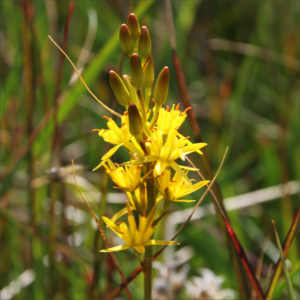
The ivy-leaved bellflower (Wahlenbergia hederacea) has delicate, hairless, creeping stems and small, pale blue, veined, bell-shaped flowers. Its green leaves have the same shape as ivy leaves. This plant is quite rare across Ireland and is only found in County Mayo along the riverbanks of the National Park.
The marsh saxifrage (Saxifraga hirculus) is a very rare plant with a distinctive yellow flower which grows in nutrient rich wet flushes (areas where there is seepage of water from the ground). In 2011, there were only 13 known populations of this plant at 8 sites in Ireland and all were located in Co. Mayo. There are more recent discoveries of six new populations of the plant including one population in Co. Sligo.
It is a beautiful flower with bright yellow petals with red spots at the base. It flowers from July to September and adds a splash of colour to the bog. The decline of this species is believed to be due to the drainage and exploitation of its peatland habitat.
Conservation Status:
– Flora Protection Order 1999
– Endangered – Red Data Book.
– Annex II of the EU Habitats Directive
The shining sickle moss (Drepanocladus vernicosus) is a green moss with a characteristic sickle or hook shape. The moss grows in flushes and fens where it’s not too acidic or alkaline. It particularly likes domed springheads, where alkaline water breaks through acidic peat, or areas where alkaline flushes spread onto flushed, acidic ground.
Conservation Status:
– Flora Protection Order 1999
– Annex II Habitats Directive
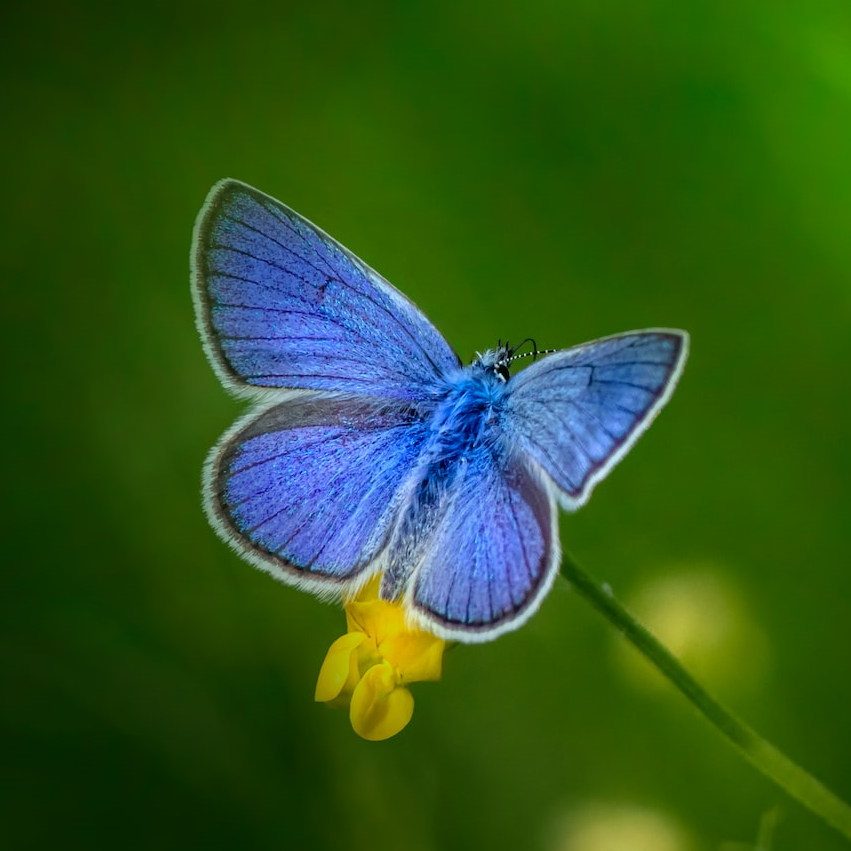
Above: Common Blue Butterfly, Polyommatus icarus
National Park Guides carry out Flower-Insect Timed Count (FIT Count) surveys to collect new data on the numbers of flower-visiting insects. FIT Counts are a very simple survey and anybody can take part in this citizen science project: just watch a patch of flowers for 10 minutes and count how many insects visit. You can then submit your data online.
The scheme runs from April to September. Doing this across various habitat types in the National Park (and repeating the count through the year and future years) will show you the impact of conservation management measures on insect numbers and diversity within the National Park.

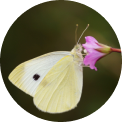
Above: Brimstone Butterfly, Gonepteryx rhamni
In Ireland we have 35 resident and regular migrant species of Irish butterfly, 20 of which have been recorded in the National Park. Butterflies are significant indicators of the state of Ireland’s environment. Taking part in the Butterfly Monitoring Scheme is another great way that our National Park Guides measure changes in biodiversity.
Although butterflies are less efficient pollinators than bees, they are an excellent group of pollinators to monitor as they are very active during the day and are easily spotted. Flowers that are red or yellow in colour or have a strong scent and produce a large amount of nectar are often pollinated by butterflies.

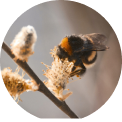
Above: Garden Bumblebee, Bombus hortorum
Our National Park Guides take part in the Bumblebee Monitoring Scheme: They record the diversity and abundance of bumblebees in the park along a 2km fixed route of the Daithí Bán Nature Trail, from March until October.
This provides essential data on bumblebee populations, which the National Biodiversity Data Centre (NBDC) uses to track changes in wild pollinators across the Irish landscape. Bumblebees you may see along this walk are representative of the community in the National Park.

Carder Bee, Bombus pascuorum
White-tailed Bumblebee, Bombus lucorum
Buff-tailed Bumblebee, Bombus terrestris
There has been a high number of bird species recorded in Ireland with over 450 species now on the Irish list, but as an isolated island for over 7,500 years, we have fewer breeding birds than our nearest neighbours. Many of these birds are migratory, either wintering from Scandinavia or breeding summer migrants from Africa.
Wild Nephin National Park provides a home for at least 80 different species of bird. The bird species of Wild Nephin National Park include some common species such as skylarks, meadow pipits and dippers and rare species including sandpipers, woodcock, dunlin, ravens, and whooper swans. Birds of prey found in the park include kestrel, sparrowhawk, merlin, peregrine falcon and hen harrier. Red grouse are resident in the park and rely on a mix of different heights of heather for shelter and food. Greenland white-fronted geese are winter visitors from Greenland and are found within the park from October to April. The main winter population of Greenland white-fronted geese are found down in Wexford at the Wexford Wildfowl Reserve. Golden Plover is a rare breeding bird that only breed in the northwest of Ireland with Wild Nephin National Park being one of their breeding sites.
There are a wide variety of mammals also present in Wild Nephin National Park. Species found in the Park include the fox (Vulpes vulpes), badger (Meles meles), Irish hare (Lepus timidus hibernicus), otter (Lutra lutra), red deer (Cervus elaphus), pine marten (Martes martes), wood mouse (Apodemus sylvaticus), pygmy shrew (Sorex minutus) and bat species including the most widespread bat found in Ireland, the soprano pipistrelle (Pipistrellus pygmaeus).
From the smooth newt (Lissotriton vulgaris) and common frog (Rana temporaria) to Ireland’s only native reptile, the common lizard (Zootoca vivipara), Wild Nephin is teeming with a diverse wildlife. Atlantic salmon (Salmo salar), among other fish species, are also resident in the National Park. When they are ready to breed, their innate homing instinct brings them back to the very same river in which they spawned to repeat the breeding cycle. If you’re lucky you may spot a salmon on its way upstream.
The golden plover is a rare breeding bird in Ireland, only nesting in the northwest counties, including Wild Nephin National Park. They are wading birds and can be regularly seen in large flocks during the winter along the coast and inland wetlands. They wade in shallow waters looking for food, mainly beetles and earthworms. Their Irish name feadóg bhuí, which means “yellow whistle”, describes their characteristic golden colour and their plaintive whistle-like call.
Golden plover were a more common breeder in Ireland but have declined due to habitat loss, predation and other factors.
Conservation Status:
– Red List – Birdwatch Ireland
– Annex I – Birds Directive
– Annex III – Bern Convention
– Annex IV – Bonn Convention
– Vulnerable – Red Data Book
– Protected by Wildlife Acts (1976 & 2000)
The merlin is a shy and rare bird of prey that nests in forestry adjacent to open heath and bog where it hunts for smaller birds and insects to feed to its young. They are small (the male only slightly bigger than a blackbird) and quite low-flying which means they can be difficult to spot. It’s worth keeping an eye out for them if you’re near forestry during the breeding season (April – June). A sign to look for are ‘kill posts’ where the merlin plucks the feathers from its prey (smaller birds) before taking it back to the nest. Look for prominent hummocks or boulders near forestry that might be used for this.
Conservation Status:
– Amber List – Birdwatch Ireland
– Annex I – Birds Directive
– Annex II – Bern Convention
– Annex II – Bonn Convention
– Rare – Red Data Book
– Protected by Wildlife Acts (1976 & 2000)
The peregrine is a bird of prey which nests high in the cliffs above the corrie lakes in the National Park. This falcon is capable of catching pigeons and ducks in flight. It is recorded as the fastest living creature on earth, reaching speeds in excess of 200km an hour as it dives down on its prey. The peregrine falcon very nearly became extinct in Ireland due to insecticides weakening the shells of their eggs, but since the introduction of a ban on the insecticide responsible, peregrines have made a dramatic recovery across the country.
Conservation Status:
– Red List – Birdwatch Ireland
– Annex I – Birds Directive
– Annex III – Bern Convention
– Annex II – Bonn Convention
– Internationally Important – Red Data Book
– Protected by Wildlife Acts (1976 & 2000)
Red grouse is a ground nesting bird which breeds in the National Park. They are almost completely dependent on heather plants for food and shelter. Their association with heather earned them the Irish name ‘cearc fhraoigh’ (hen of the heather). They normally stay under cover of heather but can burst into flight quite spectacularly if you happen to walk too close to them. The male birds have a striking red comb above their eyes. In the event that you don’t see one, you may still come across their distinct droppings which will confirm their presence.
Red grouse numbers across Ireland have been declining steadily over time due to loss of habitat, predation and other factors.
Conservation Status:
– Require close monitoring – Red Data Book
– Red List – Birdwatch Ireland
– Protected by Wildlife Acts (1976 & 2000)
Half of the world’s population of the Greenland white-fronted goose migrates from Greenland to overwinter in Ireland. They are called white-fronted because of the identifying white patch around the beaks of adults which you can see in the image. A small flock spends the winter in the National Park foraging in the wetter parts of the bog where they can pull up nutritious roots with their beaks. They are very sensitive to disturbance and will only forage for food in the most remote areas of the National Park. They need to eat a substantial amount to build up enough strength for the 3,200km flight back to Greenland where they breed.
Conservation Status:
– Amber List – Birdwatch Ireland
– Annex I – Birds Directive
– Annex III – Bern Convention–
– Annex II – Bonn Convention
– Internationally Important – Red Data Book
– Protected by Wildlife Acts (1976 & 2000)
Whooper swans arrive from Iceland in October to spend their winter in the milder climes of Ireland. Whilst here they spend their time on open farmland, feeding on grass and stubble and roosting on water in the evening. With their entirely white plumage, there is no discernible difference between the male and female, although juveniles are a grey-brown with dark heads and necks.
Conservation Status:
– Amber List – Birdwatch Ireland
– Least Concern – IUCN Red List
Ireland is regarded as the stronghold of the otter (Lutra lutra) in western Europe. Otters travel up the rivers of the National Park in search of salmon, trout and eels. They can be difficult to spot and it is often easier to find out if they are frequenting a river by searching for their spraint (droppings). Otters will often leave their spraint on prominent boulders along a river to mark their territory and the spraint, composed of fish bones, has a distinctly fishy smell.
Conservation Status:
– Annex II & IV – Habitats Directive
– Annex II – Bern Convention
– Protected by Wildlife Acts (1976 & 2000)
The Irish hare is a common sight in the National Park. If disturbed, it uses its long powerful hind legs to propel itself away at high speed, often splashing the surface water of the bog high into the air as it races away. The Irish hare is unique to Ireland in that it has adapted to the relatively snowless winters by retaining its brown coat during the winter, whereas in Scotland the hare turns white to camouflage itself in the snowy conditions. The Irish name for the hare, giorria, derives from ‘Gearr Fia’ (the short deer). While the Irish hare is considered widespread and common in Ireland, in other parts of Europe, it is regarded as threatened.
Conservation Status:
– Annex V – Habitats Directive
– Internationally Important – Red Data Book
– Annex III – Bern Convention
– Protected by Wildlife Acts (1976 & 2000)
Red deer (Cervus elaphus) is the largest land mammal in Ireland. They once roamed freely across the Nephin Mountains but were hunted to extinction locally in the 19th century. They are beginning to become a feature of the mountains again after red deer of farmed origin were introduced into the north Mayo area. The best time to see them is at dawn or dusk as they generally stay under the cover of forest during the day. You can also hear them during the rut (the breeding season) in autumn when the stags can be heard roaring to attract females.
Conservation Status:
– Protected by Wildlife Acts (1976 & 2000)
The black and white striped face of the badger (Meles meles) is normally associated with the hedgerows and woodlands of lowlands but they are also surprisingly common in upland areas such as the Nephin Mountains. Being nocturnal (active at night), badgers are difficult to observe but you may spot their tracks in soft ground. Their tracks are quite distinct due to their extra long claws which they use for burrowing out their setts. You may also spot a sett, which may appear to be a large hole in the ground but the excavated burrowings of the badger at the mouth of the hole will identify it as a badger sett.
Conservation Status:
– Annex III – Bern Convention
– Protected by Wildlife Acts (1976 & 2000)
Pine martens are mainly active at night and dusk. They have small, rounded, highly sensitive ears and sharp teeth adapted for eating small mammals, birds, insects and frogs.
The marten is still quite rare in Ireland, but the population is recovering and spreading; its traditional strongholds are in the west and south, but the population in the Midlands has significantly increased in recent years. The return of the native pine marten has impacted the non-native invasive grey squirrel, which has indirectly allowed red squirrel populations to recover.
Conservation Status:
– Least Concern – IUCN Red List
– Annex V – EU Habitats Directive
– Annex III – Bern Convention
– Protected by Wildlife Acts (1976 & 2000)
Sources: Wikipedia
The red fox is Ireland’s only member of the Canidae family. They are easily recognisable by their small doglike appearance. Colouration consists of a reddish to brown tint with a long bushy tail often with a white tip. The underbelly consists of a white to grey texture, black markings are present on the ears, feet and whiskered muzzle. The coat is moulted in spring with a second phase of hair growth occurring in the autumn to produce a heavier winter coat. There are variations in colour with some individuals having darker or silver tinted coats. The body is long and sleek with a pointed head and muzzle with sharp pointed upright ears.
Conservation Status:
– Protected by Wildlife Acts (1976 & 2000)
Sources: Conservation Ireland
Atlantic salmon (Salmo salar) spawns in the shallow gravel beds of the rivers within the National Park. After spending some time as juveniles in the rivers they eventually migrate out to the salt waters of the open Atlantic ocean where they continue to grow in size. When they are ready to breed, their innate homing instinct brings them back to the very same river in which they spawned to repeat the breeding cycle.
Conservation Status:
– Annex II & V – Habitats Directive
– Annex III – Bern Convention
– Internationally Important – Red Data Book
– Internationally Important – Red Data Book
– Protected by Fisheries Acts
Of the three species of amphibian found in Ireland the common frog is by far the most familiar. Most people think of frogs as aquatic creatures, but in fact they spend most of their lives on land, only returning to the water in order to breed.
Depending on the weather, common frogs begin to emerge from hibernation in February or March and head straight for their freshwater breeding grounds. Males usually arrive before females and start croaking to attract a mate. Eventually the female will lay 1000 to 4000 eggs which are fertilised by the male as they are released. This frogspawn floats in clumps protected by a jelly-like coating until the tadpoles emerge after 30-40 days.
Conservation Status:
– Least Concern – IUCN Red List
Sources: Ireland’s Wildlife
The common lizard is Ireland’s only native reptile and is described as viviparous, meaning it gives birth to live young. The young lizards break free from their eggs while still inside their mother and then emerge as living reptiles. Females typically give birth to 2-12 fully developed young and can often be seen sunning themselves on dry stone walls, rocks or logs during the summer months. They occupy a range of habitats, including woodland, marshes, heath, moors and bogs.
Lizards can be eaten by larger predators such as birds of prey (they typically form part of the kestrel’s diet), and stoats and mink will kill them if they can catch them. If caught by the tail, lizards have the ability to shed the lower portion, (which soon grows back) allowing them to escape.
Conservation Status:
– Least Concern – IUCN Red List
Sources: Ireland’s Wildlife
Although the predominant habitat is Atlantic blanket bog, Wild Nephin National Park supports a number of important habitat types ranging from grasslands, heathlands, shingle shores, pristine rivers (that include the Owenduff and Tarsaghaun), corrie lakes and some of the most remote mountain peaks in Ireland. These habitats are home to plants and animals of both national and international importance. Our aim is to conserve, and if necessary, enhance the quality of these habitats.
Bogs are areas of waterlogged ground where dead plant material can’t fully decompose, and forms a brown substance called peat. Plants that are tolerant of the waterlogged conditions such as sphagnum mosses grow on the surface of the peat. As these plants die off they add to the peat, which continues to accumulate. This process has been taking place over thousands of years and has resulted in an extensive blanket of peat over lowland areas and mountain slopes. This blanketing phenomenon is what gives blanket bogs their name.
Conifer plantations are large uniform stands of non-native evergreen trees such as Sitka spruce (Picea sitchensis), and lodgepole pine (Pinus contorta), that were planted on a commercial basis for their timber. They support a smaller diversity of plant and animal species compared to native forests, but they provide shelter to red deer, and are important habitat for pine marten. Conifer plantations are also important to birds, such as tits, woodcock, crossbill, and merlin.
Grasslands are dominated by grass species but flowering broad-leaved herbs and dwarf shrubs do also occur. Grasslands occur in areas where the soil is relatively free draining, usually on slopes where the soil doesn’t become waterlogged. Grasslands are dependent on a certain amount of grazing to prevent them from developing into heath and scrub.
Fens are peat-forming wet areas, which differ from bogs in that they are mostly fed by water flowing through the ground or flowing on its surface rather than by rainfall. This water picks up additional nutrients on its way which enables certain plant species to survive.
Flushes are usually smaller features that are maintained by the movement or seepage of water and occur on slopes. One very rare species of flower, the marsh saxifrage, can only be found in such flushes.
Heath derives its name from heather which is a group of small woody shrubs, the most common species being ling, bell heather and cross-leaved heath. Found commonly on slopes where the soil doesn’t become waterlogged, heather can dominate whole mountain sides. Heath is an extremely important habitat for red grouse, a bird which is almost completely dependent on heather as its primary food source.
Lakes and ponds are enclosed bodies of freshwater, varying in size from small pools out on the open bog to large lakes which have formed high in the hollows of mountain corries. Corries are hollows found on mountainsides which were carved out by the action of glaciers during the last ice age. The water in the lakes comes from rainfall, either falling directly into the lake or as a result of percolating through the brown peat of the surrounding bog. As it percolates, the water becomes acidic and acquires a dark colour.
Due to high levels of rainfall in Wild Nephin National Park the slopes of the mountains are lined with mountain streams. The steep gradient and high water levels cause the streams to be highly erosive, cutting valleys into the mountain slopes. On lower ground these streams converge into the larger rivers in the Park such as the Owenduff River and the Tarsaghaunmore River which meander their way through the bog.
These rivers are relatively shallow but their levels rise quickly after rainfall and can be extremely treacherous to cross. The water is dark coloured as a result of rainfall percolating through the peat of the bog. This dark colour is what has given the Owenduff its name, Owenduff being an Anglicisation of the Irish Abhainn Dubh, which means “the black river”. The rivers are particularly important as a breeding ground for Atlantic Salmon (Salmo salar), which migrate from the open sea back to the river in which they were originally spawned, to repeat the breeding cycle.
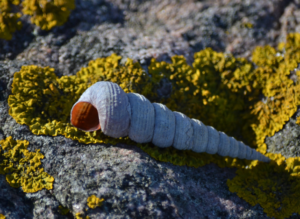
Glacial activity over the past 2.5 million years has created some of the most scenic features. These include the many corrie lakes such as Corryloughaphuill Lough. Glacial till (boulder clay), found at the southern edge of the Nephin Beg mountain range, is further evidence of glacial activity.
It also forms part of a larger area (now c. 86 ha) designated as a candidate SAC. The Nature Reserve is wholly owned by the State and is designated a Nature Reserve through Statutory Instrument No. 333 of 1984, having been identified as an Area of Scientific Interest in 1979. The woodland is probably less than 200 years old, and has become established through a combination of planting, grazing, felling, coppicing and natural ecological succession.
Most of the Nature Reserve comprises mixed broadleaved woodland, but there are also small areas of scrub, heath and dense bracken. There is a mosaic of woodland types, of which sessile oak (Quercus petraea) woodland is the most important and the main justification for its designation as a Nature Reserve. The woodland canopy comprises mainly sessile oak, beech (Fagus sylvatica), ash (Fraxinus excelsior), grey willow (Salix cinerea), sycamore, horse-chestnut and downy birch, with occasional specimens of other species, including common lime, Scot’s pine and Sitka spruce (Picea sitchensis).
There is a rich understorey of trees and shrubs including abundant holly, hazel, rowan and occasional hawthorn, grey willow, downy birch and saplings of the canopy species, especially beech. The shrub layer is variable, but often consists of dense stands of bramble, as well as honeysuckle and bilberry. The herb or ground layer is also variable. In places, it is dominated by great wood-rush, but elsewhere there is abundant ivy, lesser celandine, wood sorrel, bracken, buckler ferns, opposite-leaved golden saxifrage and occasional patches of bluebell.
Clew Bay, Co. Mayo
Oak Woodland
Old Head Nature Reserve